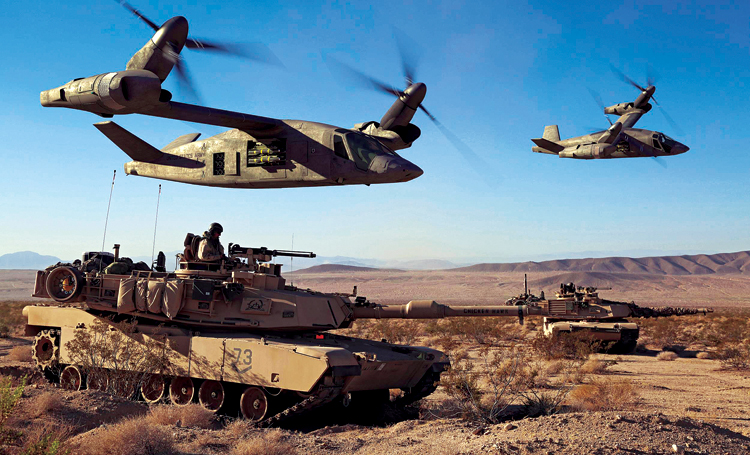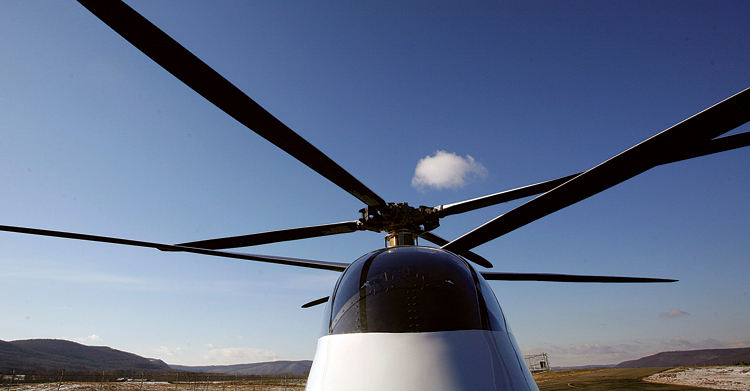INDIAN ARMED FORCES CHIEFS ON
OUR RELENTLESS AND FOCUSED PUBLISHING EFFORTS

SP Guide Publications puts forth a well compiled articulation of issues, pursuits and accomplishments of the Indian Army, over the years

I am confident that SP Guide Publications would continue to inform, inspire and influence.

My compliments to SP Guide Publications for informative and credible reportage on contemporary aerospace issues over the past six decades.
Next-Gen Combat Helicopters
Technology has been tardy in addressing speed and design problems of rotary-wing platforms; but there are some developments afoot in the vertical lift machines

The rotary-wing platform, lagging behind fixed-wing due to comparatively greater technological challenges, provided remarkably alluring options to the commander on the battlefield, ever thirsting for a high vantage point, speed of manoeuvring and the flexibility of quick redeployment. Vietnam, Korea and Iraq as also several other military conflicts, helped the helicopter to mature from casualty evacuation to increasingly more offensive tasks such as attack, anti-tank, suppression of enemy air defences, reconnaissance and observation, airlift of troops, cargo resupply and fire fighting. The term combat helicopters is used loosely to include all rotary-wing platforms and increasingly, all vertical lift platforms, that are armed and equipped to engage targets or to perform other military missions in the battlefield or elsewhere such as terrorism in urban scenarios. Some self defence is implicit to the term and unarmed craft performing tasks in the battlefield are excluded. Maritime roles fitting this definition loosely, are included in keeping with the distension of the ‘battlefield’ into the more comprehensive ‘battle space’.
NEXT-GEN COMBAT HELICOPTERS
While fixed-wing combat aircraft design has attained ‘fifthgeneration’ status and is knocking on the doors of ‘sixth-generation’ research and development, helicopter design largely still conforms to the tadpole-like appearance it was originally born with. Technology has been tardy in addressing speed and design problems of rotary-wing platforms; but there are some developments afoot in the vertical lift machines (Vertical Take Off and Landing or VTOL) which depart from the tadpole envisagement. There are also changes being made to the old shape to incorporate new features of design for higher speeds, stealth, manoeuvrability, agility, survivability and crash worthiness. However, the evolution is agonisingly slow. So, is there a Next-Gen Combat Helicopter on the horizon? While the term has not found a place in the military rotorcraft lexicon as yet, the United States (US) has taken the lead in investing money and intent into a formal programme to address the problem of designing futuristic helicopters. The programme is called Future Vertical Lift (FVL) and has evoked considerable interest amongst avid watchers of military aerospace design and development.
Artificial Intelligence is progressing at a spectacular pace and manmachine interface is being invaded by new trends in autonomous, hybrid and optionally piloted machines
FUTURE VERTICAL LIFT (FVL)
The US is inarguably the world leader in use of military helicopters. The US Army alone operates more than 4,000 helicopters in various military roles and, with an eye on the future (next-gen?) helicopter design, it took the lead in encouraging VTOL design with a combination of rotor and fixed-wing for future use. The programme is called Future Vertical Lift (FVL) and its objective time frame targets 2030. Towards the consummation of FVL, a US Army-led programme, the Joint Multi-Role (JMR) Technical Demonstrator, has been initiated with a bold wish-list with inputs from the Coast Guard, Special Operations Command and NASA. The final intent is to produce VTOL designs with significantly improved avionics, electronics, range, speed of 200 knots, survivability, operating altitudes and payloads. The “multi-role” part of the programme alludes to several roles ranging from attack configurations to cargo, medevac, search and rescue as also anti-submarine warfare. Originally, three Capability Sets were planned in 2009: JMR Light (Scout version to replace the OH-58 Kiowa), JMR Medium-Light, JMR Medium (Utility and Attack versions). Later on, two more sets were added: JMR Heavy (Cargo version to replace the CH-47 Chinook) and JMR Ultra (Ultrasized version for vertical lift aircraft with performance similar to fixed-wing tactical transport aircraft). Eventually, these new designs are expected to replace 25 current rotorcraft types in use with the US military, not just the US Army.

In the first phase, the stress has been on the “Medium” category which is planned as the replacement for the US Army’s Sikorsky UH-60 Black Hawk and the Boeing AH-64 Apache. The main contenders for this category are Bell Helicopter and a Sikorsky/Boeing team. Bell is offering a next-generation tilt-rotor, V-280, evolved from its V-22 Osprey, which tilts its huge rotor blades between vertical and horizontal positions to gain both the best features of a helicopter (vertical takeoff and landing) and those of a propeller plane (fuel-efficient speed for long range flight). The Sikorsky-Boeing Defiant looks more like a traditional helicopter, but is based on Sikorsky’s “X2” technique of combining two counter-rotating rotors, one on top of the other, with a pusher propeller at the tail. The V-280 carried out its first cruise flight in May this year and hit a top speed of 190 knots. Bell hopes to be able to increase the maximum speed to 280 knots. The Sikorsky X2 programme is progressing on the S-97 Raider (six troops and external weapons) and the SB-1 Defiant which will be a much heavier model. These two platforms are a demonstration of the X2’s scalability. The US FVL programme’s objective of replacing all US military helicopters with a family sharing common technologies, but not common platforms, is laudable and sure to bring remarkable results over the next two decades.
The high cost of development has kept the military helicopter a peg lower than the fixedwing combat aircraft in the budgetary hierarchy
While the US is the leader in the pusuit of newer VTOL designs which could provide a marginal advancement over current designs to be termed a generation leap, other technologically advanced aerospace powers are also engaged in looking for significant bounds into better VTOL performance. In Europe, Airbus Helicopters produced a prototype of the X-3, “highspeed long-range hybrid helicopter” which had a set of propellers for forward motion instead of a tail rotor and was one of the aircraft that have flown under “high-hot” conditions (6,000 feet at 95 degrees Fahrenheit) like a rotorcraft with airplanelike speed. The X-3 demonstrated a speed of 255 knots in level flight and 263 knots in a shallow dive on June 7, 2013, beating the Sikorsky X2’s unofficial record set in September 2010, thus becoming the world’s fastest non-jet augmented compound helicopter. On May 21, 2016, Airbus had filed a patent for X-3, claiming it as the world’s fastest rotarywing aircraft. However, since then no further developments seem to have taken place on the type.

THE FUTURE
Artificial Intelligence (AI) is progressing at a spectacular pace and man-machine interface is being invaded by new trends in autonomous, hybrid and optionally piloted machines. Undoubtedly, AI will complement the ongoing development initiatives in VTOL technologies to add to the complexity and employability of helicopters in the future. The rapid transgression of AI into helicopter technology and indeed aircraft technology, raises the question of manned versus unmanned technologies and, in the light of recent developments, the advantages of integrated manned-unmanned missions which have rendered better results in terms of target detection and engagement. However, high cost of development has kept the military helicopter a peg lower than the fixed-wing combat aircraft in the budgetary hierarchy. A glaring hold back in helicopters has been the introduction of Fly-By-Wire (FBW). Even the US, globally the most affluent, is coming around to the idea of modernising helicopters only for some specialised units. Less prosperous nations would obviously settle for similar or worse compromise solutions.
Another issue with future helicopters is their survivability in the emerging dense and sophisticated air defence environment in the battlefield. US Senate Armed Services Committee’s Airland subcommittee had queried the US Army earlier this year and Lt Gen Paul Ostrowski responded in the context of the JMR Technology Demonstrator programme that, “It is one of our top priorities within Future Vertical Lift”. He added that the US Army was investing heavily to develop the ability to interdict oncoming missiles in flight.
CONCLUSION
The UH-60 Black Hawk, a tried and tested combat helicopter, has been around for four and a half decades. Even as the FVL programmes seek to produce a better replacement, it is now being technologically upgraded and being given a new weapons system retrofit produced by Sikorsky. The plan is to use it for another five decades. The point worth noting here is that advances in technology are of use to helicopter evolution in two ways; firstly, new and inventive changes are being made to rotorcraft and VTOL design under new projects and programmes. Secondly, new technologies are becoming available for upgrades to active models so as to enhance their performance, survivability, capability and mission adaptability. Rather self evidently, upgrades require much lower financial outlay than a new helicopter design, although the upgraded helicopter may not turn into a new generation helicopter in terms of performance. It is thus becoming increasingly clear that the option of upgrading existing types would continue for the next decade or so. As a corollary, a new generation of helicopters, notwithstanding the FVL programme, appears distant and nebulous despite the use of the term Next-Gen Helicopters by some original equipment manufacturers on their official websites.





